Wrist watches, early-mid 20th century
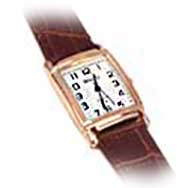
Wrist watches were very expensive before the digital era. This page explains why and goes on to discuss their accuracy and reliability, how they were set wound up and wound up and what they were like to use.
____
By the webmaster based on early experience and discussions with older people.
Why watches were so expensive
A particular far-reaching change from the world going digital was with time-pieces and especially watches. It is probably difficult for anyone born after the 1960s to appreciate the relative scarcity and cost of pre-digital watches.
There were several reasons for the high cost:
All watches consisted of moving parts which had to be made to a high degree of accuracy to keep good time, and they also had to be extremely quite tiny. Furthermore the moving parts contained jewels - albeit tiny ones - for hardness, so as to wear out more slowly than metal. Watch-makers were highly trained experts in their field and needed to be paid as such - and the parts for each watch was made individually. The acknowledged expertise seemed to reside almost entirely outside Britain in Switzerland, although how far this was actually true, I don't know.
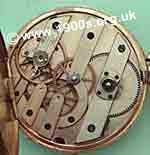
The Government clearly felt that Swiss watches were a luxury and so levied high import taxes on them. Along with alcohol and furs, which were also highly taxed imports, watches were the contraband of smugglers. Within the UK, they, along with money and jewellery were the choice of thieves because they were small enough to carry easily.
Reliability of pre-digital watches
Pre-digital watches were much less reliable than the digital versions of today. There were several reasons:
First and foremost were the difficulties of accurate miniaturisation. The Swiss were the acknowledged experts in this, but accurate miniaturisation was almost impossible to be perfect.
The mechanisms for watches were susceptible to dust which could made them work erratically. I never understood how the dust got in because the backs of their cases always remained tightly closed. Nevertheless when a watch became unreliable, it was always sent for cleaning as the first remedy, even though the result was not always satisfactory. When dust got into the mechanism, it caused wearing away and distortion, often irreversibly.
Moving parts always wear away in time and pre-digital watches were full of moving parts. The hands of a watch were kept moving by a spring inside the watch which gradually unwound. This spring had to be wound up with a winder, which was a knob on the side of the watch. Watches had to be wound up quite often: either daily or weekly.
It was all too easy to forget to wind a watch in which case it went slow then stopped.
The winder was in frequent use which could cause it to drop off and be lost. A jeweller who doubled as a watch-mender could normally provide a replacement, but of course at a cost and not necessarily matching.
Watches as status symbols
People were not necessarily assumed to have watches - or, at least, watches which told the time reliably. So it was quite normal to be stopped in the street to be asked if one knew the right time. Even by the 1950s, relatively few people owned watches. A watch was a status symbol.
Wrist watches in the 1930s-early 1960s
All the early watches had analogue screens. This meant that their faces had numbers one to twelve around the outside, a moving hand to point to hours and a longer hand to point to minutes.
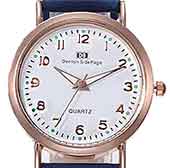
analogue face
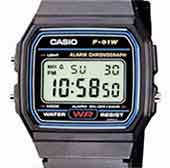
digital face
Traditionally someone's 21st birthday was the start of what was called their 'age of maturity', i.e. becoming an adult rather than a child. The date was generally marked with being given a key to the front door and with a present which was more expensive than a normal birthday present. My mother's 21st birthday present from her parents was a gold wrist watch. It was Swiss-made, miniature and very expensive in real terms. That was in 1927.
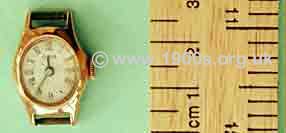
Example of ladies' wrist watches. This one is tiny, gold and from 1927, sadly with the ribbon strap missing.
It was rare for my mother to wear this watch. Perhaps she felt that it was showing off, perhaps it was too valuable to risk damage from housework, perhaps it had gone wrong, or perhaps it wasn't really functional. The face was so small with such tiny hands that a good light and good eyesight were needed for reading it. Also the strap was just a black ribbed ribbon which she referred to 'grosgrain' and which was severely frayed when I knew it. In the photo this strap is entirely missing.
Men's watches were normally larger and heavier than women's, and pocket watches were still fashionable for older men.
In all my schools, 1944-1957, it was against school rules to wear a watch, probably because watches were so expensive. I did have one as a teenager because I had strict instructions to be home by 11pm on a Saturday night. It was in a dull metal case with a brown leather strap, probably made in China or Japan.
Self-winding wrist watches: late 1960s - early 1970s
The next major pre-digital innovation in watches - in the late 1960s or early 1970s - came as self-winding watches. The idea was that they never needed to be wound up because the movements of the wrist in everyday activities worked the mechanism. I had one which ran well for a time, but then went irreversibly wrong.
My husband also had a self-winding gold watch which he liked very much but didn't wear for fear of damaging. It still worked well on a test over 50 years later and was brought out for special occasions.
Setting the time and winding up a pre-digital watch
The winder on a watch was dual purpose. If it was out, exposing its stem, it could be turned to set the minute hand. The hour hand could only be moved an hour at a time by moving the minute hand through the full 60 minutes.
With the knob pushed back in, it could be turned and back and forth repeatedly to wind the watch up. This was accompanied by a clicking sound indicating that the spring was being wound up.
The process is described in more detail on the page about winding a pocket watch.
The end of watches that needed winding
The death knoll of self-winding watches and all mechanical watches was the development of digital watches which were exceedingly cheap, entirely accurate and reliable without needing to be wound up because they were battery-operated. They do not need to have analogue faces, although some do.
| sources | webmaster | contact |
Text and images are copyright
If you can add anything to this page or provide a photo, please contact me.



